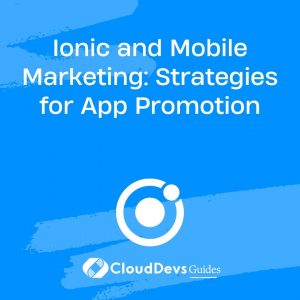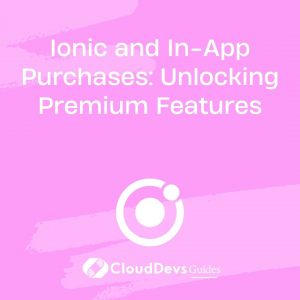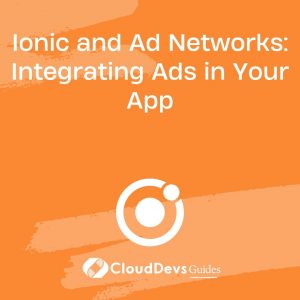Ionic and Mobile Marketing: Strategies for App Promotion
Mobile apps have become an integral part of our daily lives. From ordering food to booking flights, there’s an app for almost everything. However, creating a fantastic app is just the first step. To succeed in the highly competitive world of mobile app development, you need to master the art of app promotion. In this blog, we’ll explore the powerful combination of Ionic, a popular framework for building cross-platform mobile apps, and mobile marketing strategies to help your app reach its full potential.
Table of Contents
1. Why Ionic?
Before we dive into the strategies for app promotion, let’s briefly discuss why Ionic is a fantastic choice for developing mobile apps. Ionic is an open-source framework that uses web technologies like HTML, CSS, and JavaScript to build high-quality, cross-platform mobile applications. Here are some reasons why developers love Ionic:
1.1. Cross-Platform Compatibility
Ionic allows you to write code once and deploy it across multiple platforms, such as iOS, Android, and even the web. This significantly reduces development time and effort, making it an excellent choice for startups and businesses aiming for a broad user base.
1.2. Pre-Built UI Components
Ionic comes with a rich library of pre-designed UI components, including buttons, forms, and navigation menus. This not only speeds up development but also ensures a consistent and polished user interface.
1.3. Native-Like Performance
Ionic apps perform like native apps, thanks to its integration with Apache Cordova and Capacitor, which enable access to device features and native APIs.
1.4. Strong Community and Ecosystem
Ionic has a vibrant community of developers and a vast ecosystem of plugins, themes, and resources. This support network makes problem-solving and app development more accessible.
Now that we understand why Ionic is a great choice, let’s explore the strategies for promoting your Ionic mobile app effectively.
2. App Store Optimization (ASO)
App Store Optimization, or ASO, is a critical component of mobile app marketing. It involves optimizing your app’s listing on app stores like Apple App Store and Google Play Store to improve its visibility and discoverability. Here are some ASO strategies you can implement for your Ionic app:
2.1. Keyword Research
Identify relevant keywords that potential users might use to find apps like yours. Tools like Google Keyword Planner and App Annie can help you discover popular keywords in your niche.
javascript // Example of keyword research for a fitness app const keywords = ["fitness tracker", "workout app", "health and wellness", "exercise planner"];
2.2. App Title and Description
Incorporate your chosen keywords into your app’s title and description while keeping it informative and appealing. Make sure to highlight the unique features and benefits of your app.
html <!-- Example of an app title and description --> <title>Fitness Tracker: Achieve Your Fitness Goals</title> <meta name="description" content="Track your workouts, set fitness goals, and stay healthy with our comprehensive fitness app.">
2.3. High-Quality Visuals
Include eye-catching screenshots and videos that showcase your app’s user interface and functionality. Visuals play a significant role in convincing users to download your app.
html <!-- Example of app screenshots --> <img src="screenshot1.png" alt="Screenshot 1"> <img src="screenshot2.png" alt="Screenshot 2">
2.4. User Reviews and Ratings
Encourage satisfied users to leave positive reviews and ratings on the app store. Address negative reviews promptly and use feedback to improve your app.
javascript
// Example of encouraging reviews
if (userSatisfied) {
askForReview();
} else {
gatherFeedback();
}
2.5. Regular Updates
Continuously improve your app by releasing updates with new features, bug fixes, and performance enhancements. App stores often prioritize apps that receive frequent updates.
javascript // Example of releasing app updates const newFeature = "Introducing a personalized workout plan!"; const bugFix = "Resolved issue causing app crashes."; const performanceImprovement = "Faster loading times for a smoother experience."; releaseUpdate(newFeature, bugFix, performanceImprovement);
3. Social Media Marketing
Social media is a powerful platform for promoting your Ionic app and engaging with your audience. Here are some strategies to leverage social media effectively:
3.1. Create Engaging Content
Develop a content calendar that includes posts, videos, and graphics related to your app. Share user stories, tips, and updates to keep your audience engaged.
javascript
// Example of a social media content calendar
const contentCalendar = {
monday: "Motivation Monday: Share inspiring fitness success stories.",
wednesday: "Workout Wednesday: Post a quick workout routine video.",
friday: "Feature Friday: Highlight a unique app feature."
};
3.2. Use Appropriate Hashtags
Research and use trending and relevant hashtags to increase the discoverability of your posts. Platforms like Instagram and Twitter rely heavily on hashtags for content discovery.
html <!-- Example of using hashtags in a social media post --> <p>Ready to get fit? Try our #FitnessTracker app and start your fitness journey today!</p>
3.3. Collaborate with Influencers
Identify social media influencers in your niche and collaborate with them to promote your app. Influencers can reach a broader audience and provide authentic endorsements.
javascript
// Example of influencer collaboration
const influencer = {
name: "FitnessGuru123",
followers: 500,000,
collaborationType: "Sponsored post about our fitness app."
};
collaborateWithInfluencer(influencer);
3.4. Run Contests and Giveaways
Engage your audience by organizing contests and giveaways with app-related prizes. This not only increases app visibility but also encourages user participation.
javascript // Example of a social media contest const contestPrize = "Win a one-year premium subscription to our fitness app!"; const contestRules = "Follow us, like this post, and tag three friends to enter."; runContest(contestPrize, contestRules);
4. Paid Advertising
While organic strategies like ASO and social media marketing are essential, paid advertising can give your app a significant boost. Here are some paid advertising channels and strategies:
4.1. Google Ads
Google Ads allows you to create targeted ads that appear in search results and across Google’s network. You can specify keywords, demographics, and budgets to reach your ideal audience.
javascript
// Example of setting up a Google Ads campaign
const campaignSettings = {
keywords: ["fitness app", "workout tracker"],
demographics: {
age: "18-45",
location: "United States",
interests: "Fitness and Health"
},
budget: 5000 // Monthly budget in USD
};
createGoogleAdsCampaign(campaignSettings);
4.2. Facebook Ads
Facebook Ads lets you create highly targeted ads that appear on Facebook and Instagram. You can define your audience based on demographics, interests, and behaviors.
javascript
// Example of setting up a Facebook Ads campaign
const adSettings = {
audience: {
demographics: {
age: "18-55",
location: "Worldwide",
interests: "Fitness and Exercise"
},
budget: 10000 // Monthly budget in USD
}
};
createFacebookAdsCampaign(adSettings);
4.3. App Store Ads
Consider running ads directly within app stores to promote your app to users actively browsing for new apps to download. Both Apple and Google offer in-app advertising options.
javascript
// Example of setting up an App Store Ads campaign
const appStoreAdSettings = {
platform: "iOS",
ad placement: "Search Ads",
budget: 2000 // Monthly budget in USD
};
createAppStoreAdsCampaign(appStoreAdSettings);
5. Measure and Analyze
To fine-tune your marketing strategies, it’s essential to measure the results of your efforts. Use analytics tools to gather data and gain insights into user behavior, conversion rates, and user demographics.
5.1. Google Analytics
Integrate Google Analytics into your Ionic app to track user interactions, app usage, and conversions. Analyze the data to identify areas for improvement.
javascript // Example of setting up Google Analytics for an Ionic app const trackingCode = "UA-12345678-1"; // Replace with your tracking code initializeGoogleAnalytics(trackingCode);
5.2. A/B Testing
Run A/B tests to compare different marketing approaches, such as app icons, descriptions, or ad copy. Determine which variations perform better and optimize accordingly.
javascript // Example of setting up A/B testing for app icons const originalIcon = "icon.png"; const newIcon = "new-icon.png"; runABTest(originalIcon, newIcon);
Conclusion
Promoting your Ionic mobile app effectively requires a combination of organic and paid marketing strategies. App Store Optimization (ASO), social media marketing, and paid advertising are all valuable tools in your promotional arsenal. Additionally, measuring and analyzing user data helps you refine your strategies for better results. By implementing these strategies and continuously improving your app, you can increase its visibility, downloads, and ultimately, its success in the competitive mobile app market.
Remember that app promotion is an ongoing effort. Stay engaged with your audience, adapt to changing trends, and keep innovating to ensure your Ionic app remains a top choice for users in your niche. With dedication and the right marketing strategies, your app can reach its full potential and make a significant impact in the mobile app landscape.
Table of Contents








